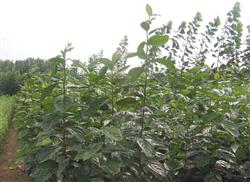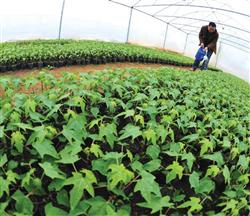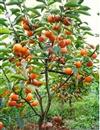How to make young persimmon trees survive the winter safely?

The cold resistance of young persimmon is poor, and the phenomenon of overwintering often occurs, so effective measures must be taken to ensure its safe overwintering. 1. Early irrigation of frozen water. Pouring enough frozen water in the middle and late October before the persimmon leaves fall and ploughing and raking a few days later can reduce the frozen layer and ensure the water needs of the roots. 2. Bury the earth to guard against the cold. Before freezing, gently press the 1-2-year-old young trees that can be pulled down to the windward and bury them into a mound, with no branches exposed and airtight as the principle, and gently pat them with a spade after burying. 3. Mulching grass to compress fertilizer. Young trees that cannot be overwhelmed can be covered with 10-15 cm thick wheat straw, deciduous leaves, green manure, etc., sprinkled with 20 kg of organic manure and compacted with soil. 4. Covering and wrapping film. Cover the tree plate with plastic film before overwintering to increase the ground temperature. At the same time, the trunk and side branches of the tree were tightly wrapped with plastic film to restrain the evaporation of water in the tree. 5. Entangling grass to cultivate soil. Wrap the branches with wheat straw and straw (split longitudinally) before winter, or use wheat straw and green manure to wrap tightly around the trunk and large lateral branches, and cultivate the soil at the base of the trunk after entangling, but the soil should be removed in time in spring to increase the ground temperature and promote the root system to move as soon as possible to absorb water in time to meet the needs of aboveground evaporation. 6. Enclosing ridges to block the wind. In the northwest of the young tree 40-50 cm from the root, the heap about 50 cm high semicircular windshield ridge, the main purpose is to protect the root neck from freezing. 7. Spray protective agent. The young trees without grass entanglement were sprayed with 5-fold paraffin emulsion and 150-200-fold carboxycellulose for 2-3 times before winter and early spring in February-March to seal the stomata of branches and trunk and reduce water loss.
- Prev

Seedling raising techniques of papaya
Papaya, also known as wrinkled papaya, is the dry nearly mature fruit of Malus rosaceae. it mainly produces Shandong, Anhui, Sichuan, Hubei, Yunnan and Shaanxi provinces. it has the functions of relieving cough and relieving spasm, clearing heat and diuresis, relaxing muscles and activating collaterals, and stomach dampness. in recent years, papaya beverage, papaya wine, preserved fruit, canned fruit and chemical have been developed.
- Next

High-quality and High-yield cultivation techniques of Sweet Persimmon
The establishment and planting of the garden. Sweet persimmon is not strict on soil, but the sandy soil with PH value of 5.57.5 is the best. The annual average temperature is above 13 ℃. Most varieties of sweet persimmon only have female flowers, but they can bear fruit unisexually. If pollinated varieties are planted, it is more beneficial to production. The main varieties should be marketable, with large fruit shape, beautiful appearance and pulp.
Related
- Moge, come on! The staff of the peasant association in the producing area of cantaloupe were frightened when the crowd gathered.
- Causes and Solutions of low Fruit setting rate of Apple
- Symptoms and control measures of passion fruit virus disease
- Fruit growing lesson: how do apple orchards keep high yields?
- Can you build orchards in the mountains? What are the pros and cons?
- How to manage the coloring period of Crisson grape?
- This paper introduces the processing technology of two kinds of fig products.
- How much is a month for retired teachers in rural areas by 2020?
- How can strawberry planting increase sugar content? We should pay attention to management in many aspects.
- What are the cultivation techniques on how to improve the yield of golden fruit?

